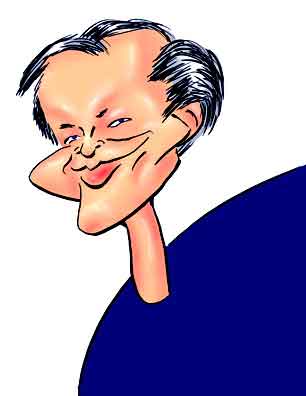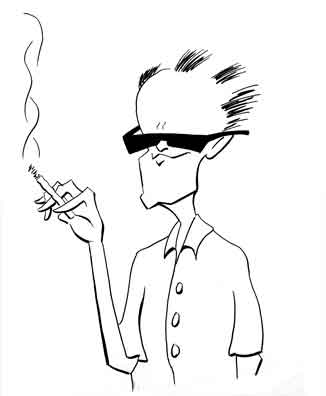Young Jack Nicholson
The Early Films

Young Jack Nicholson
You'll be surprised.
With Jack Nicholson now being the grand old man super-megastar of Hollywood and winner of three Academy Awards, it's sometimes forgotten he was once a young and struggling actor doing his best to scrape by. And unless you're a big fan of Jack's you'll be surprised at some of his early movies.
One of Jack's earliest roles of substance was in 1960 - Jack was 23 - and he played the part of Weary Reilly in Studs Lonigan, a largely forgotten film based on a largely forgotten novel by the now largely forgotten American writer, James T. Farrell, and starring the largely forgotten actor, Christopher Knight. For those who have neither seen the movie or read the books - the majority of people - Weary was a bad guy who - in the novel - pounds a drunken Studs into the ground on New Years Eve, 1929. The movie as often happens has but limited semblance to the novel.
Jack, though, had appeared in an earlier movie although it was released the same year as Studs. This was in The Little Shop of Horrors. We refer to the movie directed and produced by Roger Corman and not the musical of the 1980's (Jack did not appear in the later productions). Jack's part in The Little Shop of Horrors was near vanishingly small, and supposedly the film was shot in three days - not an unusually short time for some of Roger's early movies.
But Jack's first major role - actually almost all the actors in the film had major roles - was in the 1963 horror spoof, The Raven. This was also directed by Roger who in 1960 began making movies starring the big three of mid-20th century horror movies: Vincent Price, Peter Lorre, and Boris Karloff. All three of these titans starred in The Raven and Jack played Peter Lorre's fussy son, Rexford. Peter himself played the part of a not very skillful magician whom Boris - playing the evil magician Dr. Scarabus - had turned into the raven.
Using the sets left over from The Raven, Roger soon began directing another film The Terror. This movie may be considered Jack's first starring role although he actually stood second in credits to Boris. The Terror is also probably the champ of all movies for being shot out of sequence. One story is that some of Jack's scenes were filmed months apart, and this is why you can see his hairline recede.
Throughout the 1960's Jack had a number of smaller roles in popular television shows ranging from Sea Hunt to Dr. Kildare to the Andy Griffith Show. But Jack had begun venturing into writing and production and provided Roger with three scripts, one of which was for the surprisingly successful 1967 film The Trip. This was a hippie - sorry, that's "counterculture" - movie which featured Peter Fonda, the son of iconic actor Henry Fonda, as well as another established actor, Dennis Hopper. The Trip made Roger a ton of money and got Jack thinking more of the off-stage opportunities of the film industry. So as the Revolutionary (some say Mythical) 1960's began to draw to a close, Jack was known to those in the film industry but by no means a star.
Peter had also been appearing in movies and television shows since the early 1960's. One of his best roles was and is an episode from the Alfred Hitchcock Hour, "The Return of Verge Likens". If you can see this show, do so. Everyone from Peter to George Lindsey (Goober on Andy Griffith but in a very non-Goober role) to the sympathetic Sammy Reese to the insufferable Robert Emhardt put on great performances. We won't reveal the quintessential Hitchcock ending.
But after starring in The Trip, Peter himself decided to produce an independent film about the counterculture. He originally had approached Roger for financing, but Roger and his distributors, James Nicholson (no relation to Jack) and Samuel Arkoff, were dubious about being associated with a movie where the - quote - "heroes" - unquote - were a couple of hippies riding around on motorcycles pushing and using drugs. Jack suggested Peter try Robert Rafelson and Bert Schneider who, as the brains behind the hit TV show The Monkees, had considerable cash flow. At their first meeting Bert wrote Peter a personal check to cover the starting costs, and the movie was off and running. Dennis would direct, and he and Peter would be the stars. If the stories be true, it was not a smooth production. At one point Jack remarked "Everyone wanted to kill one another."
Peter and Dennis had known Jack for years. Since the Terror, he had appeared in a number of movies. In the shows that did well, his parts were minor, and at times uncredited. Shows where he had a lead or starring role were box office flops and today are largely forgotten. But he had taken an interest in the production side of the films and knew the ins and outs of making a film that at least could reach the box office.
But neither Peter nor Dennis saw Jack as a great actor. So he started off working behind the scenes. Still there was a third part - that of a drunken southern lawyer - that had yet to be cast. Peter and Dennis first offered the role to Bruce Dern, another veteran of the Corman films but who now was well established in his own acting career. When Bruce turned it down - with such a low budget Peter and Dennis could only make an up front offering of scale - they turned to Rip Torn who even before his Men in Black roles was a well known but cantankerous character actor. But Rip wasn't interested either, telling Dennis "I'm not going to do your [inconsequential] film".
So finally Peter suggested Jack take the role. Dennis didn't like the idea, but on finding Jack could put on at least a semblance of a Texas accent, ultimately agreed. Whether landing the role was Jack's original intent or not isn't clear but at the time he seemed to take the part reluctantly.

Jack Nicholson
Megastar
A personal CooperToons opinion - admittedly a minority report - is the acting is mediocre at best and the plot hokey even for the time, and the score consisting of disjoint rock and roll songs was fine for making a best selling soundtrack but added little to the movie itself. Still the film was quite popular with the kids; less so with the parents as might be expected of a movie where the heroes were cocaine dealers. Comic artist Al Capp, creator of Li'l Abner and known for his outspoken conservative views, said the best thing about the film was its happy ending.
Happy ending or not, mediocre acting and plot or not, Easy Rider was one of the biggest hits of the year 1969. Then in 1970, Bob Rafelson (see above) was looking for an actor for the lead in Five Easy Pieces and thought Jack would fit the bill. From then on Jack could write his own ticket.
References
Jack's Life: A Biography of Jack Nicholson, Patrick McGilligan, Norton, 1994
How I Made A Hundred Movies In Hollywood And Never Lost A Dime, Roger Corman, Da Capo Press, 1998